Unit 1 Good morning教案(表格式,2课时) 鲁教版(五四制)英语六年级上册
文档属性
| 名称 | Unit 1 Good morning教案(表格式,2课时) 鲁教版(五四制)英语六年级上册 | 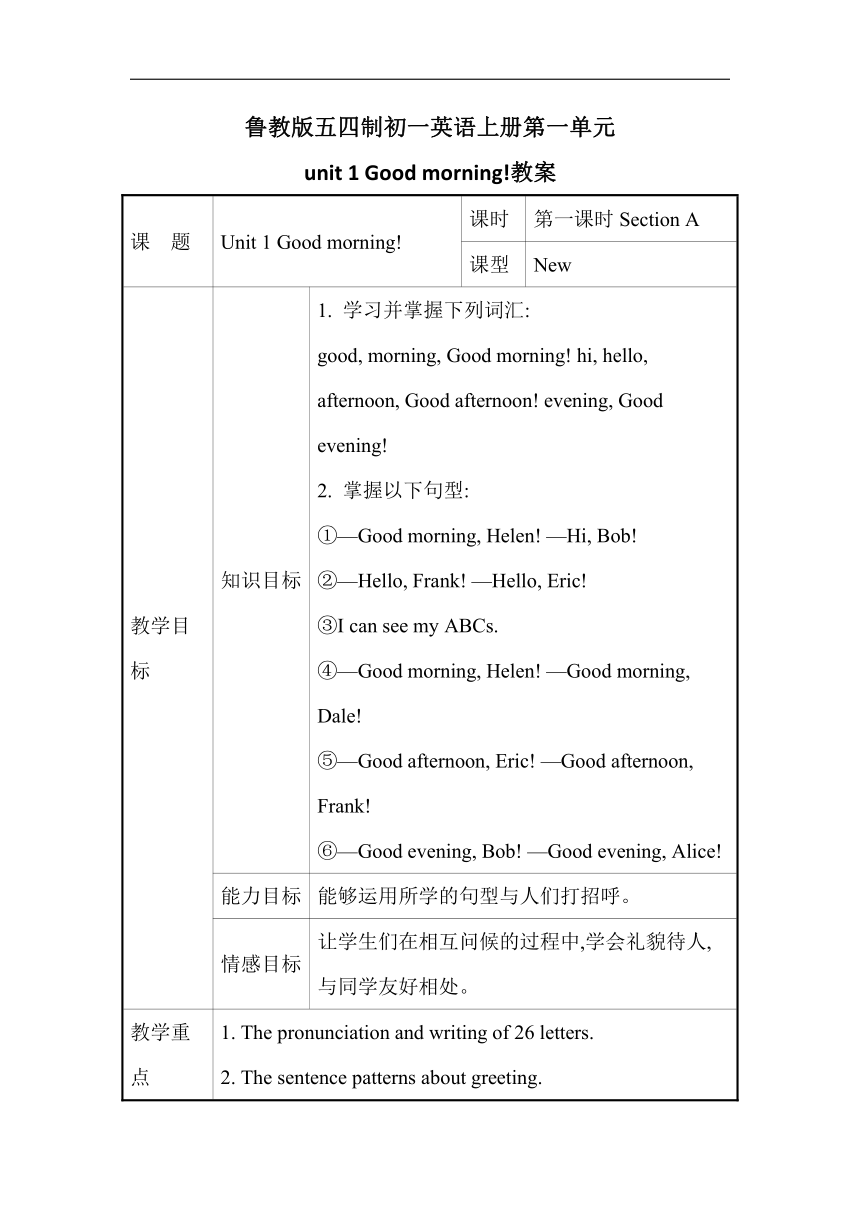 | |
| 格式 | docx | ||
| 文件大小 | 130.7KB | ||
| 资源类型 | 教案 | ||
| 版本资源 | 鲁教版 | ||
| 科目 | 英语 | ||
| 更新时间 | 2024-02-01 10:15:35 | ||
图片预览

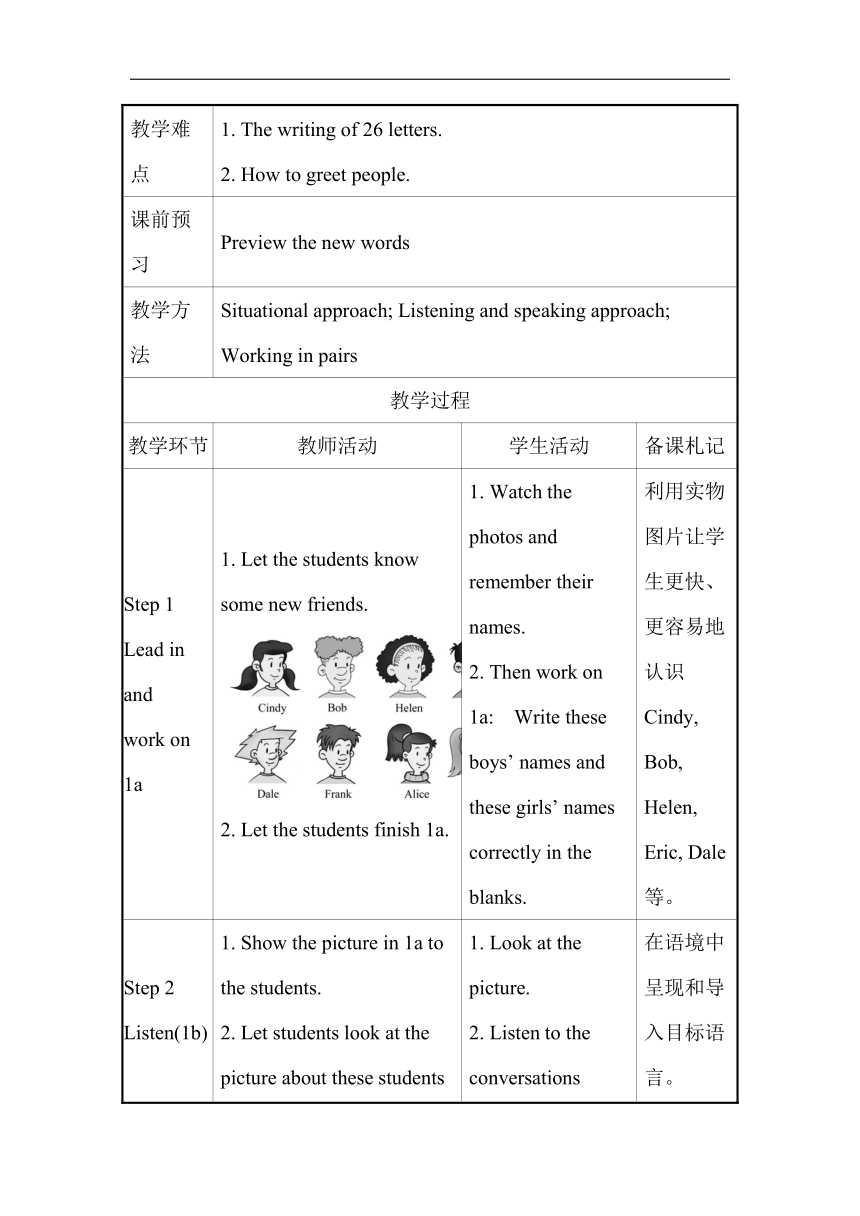
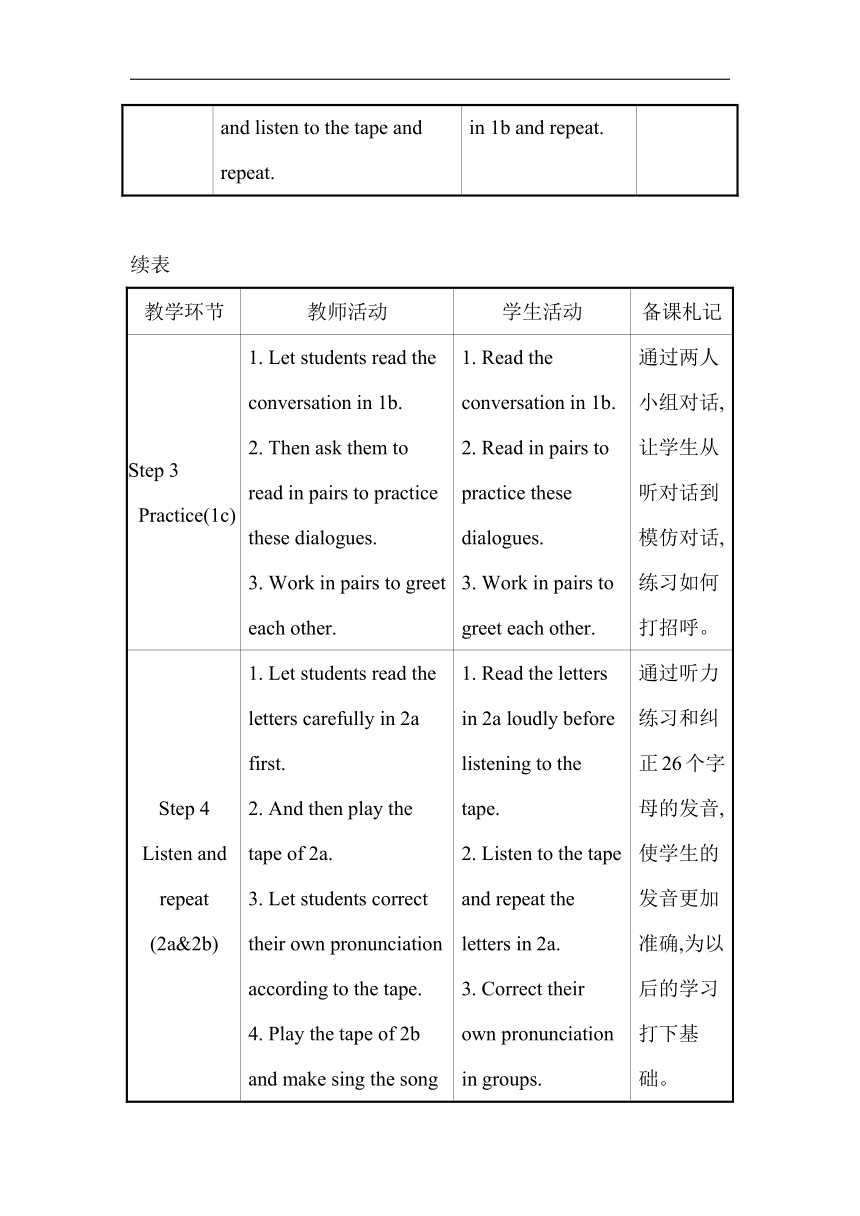
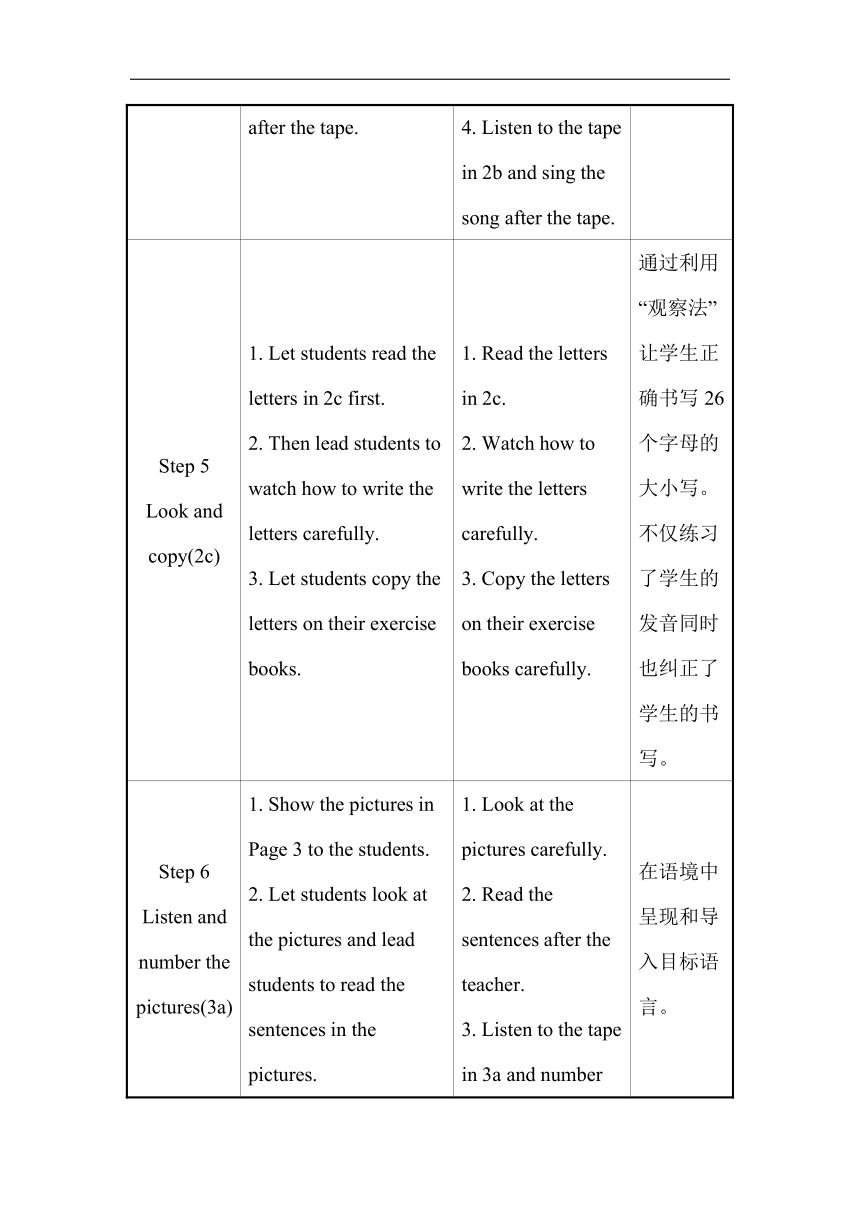
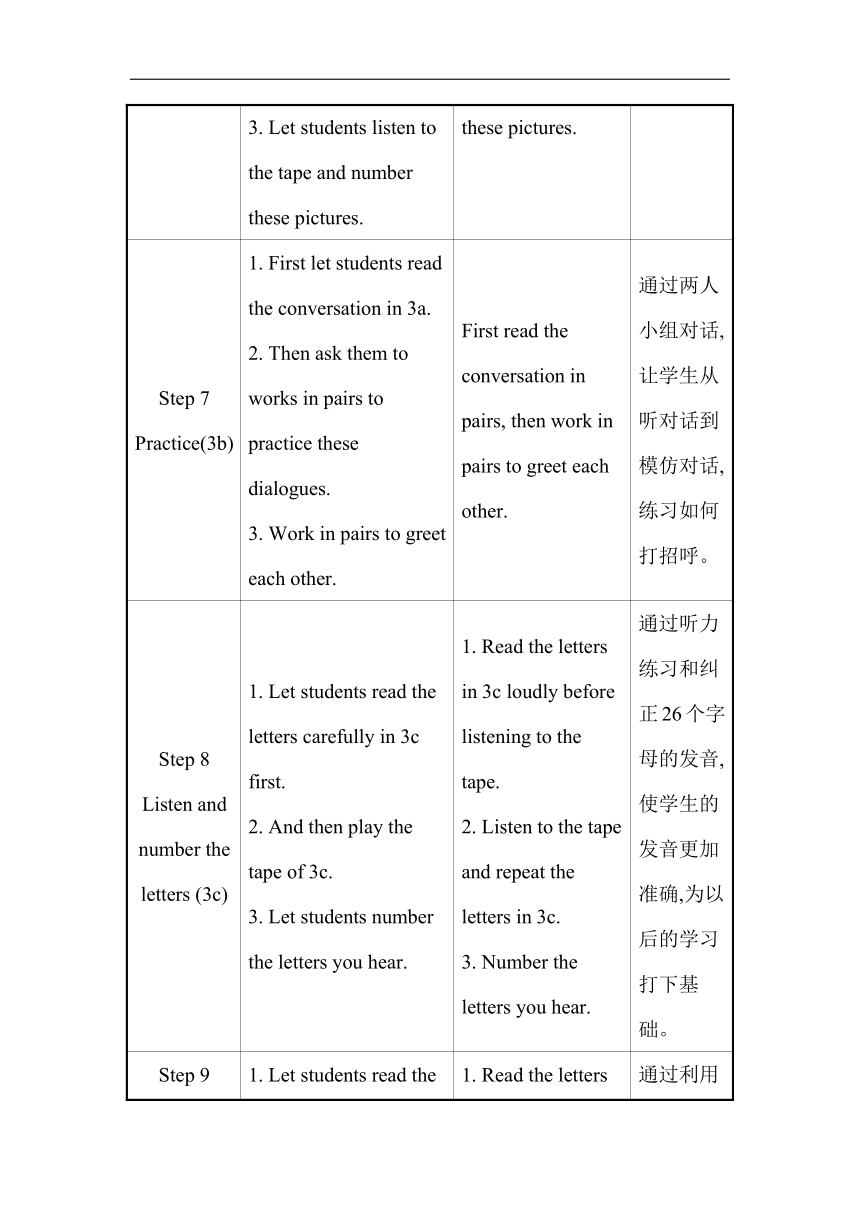
文档简介
鲁教版五四制初一英语上册第一单元
unit 1 Good morning!教案
课 题 Unit 1 Good morning! 课时 第一课时Section A
课型 New
教学目标 知识目标 1. 学习并掌握下列词汇: good, morning, Good morning! hi, hello, afternoon, Good afternoon! evening, Good evening! 2. 掌握以下句型: ①—Good morning, Helen! —Hi, Bob! ②—Hello, Frank! —Hello, Eric! ③I can see my ABCs. ④—Good morning, Helen! —Good morning, Dale! ⑤—Good afternoon, Eric! —Good afternoon, Frank! ⑥—Good evening, Bob! —Good evening, Alice!
能力目标 能够运用所学的句型与人们打招呼。
情感目标 让学生们在相互问候的过程中,学会礼貌待人,与同学友好相处。
教学重点 1. The pronunciation and writing of 26 letters. 2. The sentence patterns about greeting.
教学难点 1. The writing of 26 letters. 2. How to greet people.
课前预习 Preview the new words
教学方法 Situational approach; Listening and speaking approach; Working in pairs
教学过程
教学环节 教师活动 学生活动 备课札记
Step 1 Lead in and work on 1a 1. Let the students know some new friends. 2. Let the students finish 1a. 1. Watch the photos and remember their names. 2. Then work on 1a: Write these boys’ names and these girls’ names correctly in the blanks. 利用实物图片让学生更快、更容易地认识Cindy, Bob, Helen, Eric, Dale等。
Step 2 Listen(1b) 1. Show the picture in 1a to the students. 2. Let students look at the picture about these students and listen to the tape and repeat. 1. Look at the picture. 2. Listen to the conversations in 1b and repeat. 在语境中呈现和导入目标语言。
续表
教学环节 教师活动 学生活动 备课札记
Step 3 Practice(1c) 1. Let students read the conversation in 1b. 2. Then ask them to read in pairs to practice these dialogues. 3. Work in pairs to greet each other. 1. Read the conversation in 1b. 2. Read in pairs to practice these dialogues. 3. Work in pairs to greet each other. 通过两人小组对话,让学生从听对话到模仿对话,练习如何打招呼。
Step 4 Listen and repeat (2a&2b) 1. Let students read the letters carefully in 2a first. 2. And then play the tape of 2a. 3. Let students correct their own pronunciation according to the tape. 4. Play the tape of 2b and make sing the song after the tape. 1. Read the letters in 2a loudly before listening to the tape. 2. Listen to the tape and repeat the letters in 2a. 3. Correct their own pronunciation in groups. 4. Listen to the tape in 2b and sing the song after the tape. 通过听力练习和纠正26个字母的发音,使学生的发音更加准确,为以后的学习打下基础。
Step 5 Look and copy(2c) 1. Let students read the letters in 2c first. 2. Then lead students to watch how to write the letters carefully. 3. Let students copy the letters on their exercise books. 1. Read the letters in 2c. 2. Watch how to write the letters carefully. 3. Copy the letters on their exercise books carefully. 通过利用“观察法”让学生正确书写26个字母的大小写。不仅练习了学生的发音同时也纠正了学生的书写。
Step 6 Listen and number the pictures(3a) 1. Show the pictures in Page 3 to the students. 2. Let students look at the pictures and lead students to read the sentences in the pictures. 3. Let students listen to the tape and number these pictures. 1. Look at the pictures carefully. 2. Read the sentences after the teacher. 3. Listen to the tape in 3a and number these pictures. 在语境中呈现和导入目标语言。
Step 7 Practice(3b) 1. First let students read the conversation in 3a. 2. Then ask them to works in pairs to practice these dialogues. 3. Work in pairs to greet each other. First read the conversation in pairs, then work in pairs to greet each other. 通过两人小组对话,让学生从听对话到模仿对话,练习如何打招呼。
Step 8 Listen and number the letters (3c) 1. Let students read the letters carefully in 3c first. 2. And then play the tape of 3c. 3. Let students number the letters you hear. 1. Read the letters in 3c loudly before listening to the tape. 2. Listen to the tape and repeat the letters in 3c. 3. Number the letters you hear. 通过听力练习和纠正26个字母的发音,使学生的发音更加准确,为以后的学习打下基础。
Step 9 Talk about what these letters mean. (3d) 1. Let students read the letters in 3d first. 2. Then make students watch the letters and their pictures 3. Make the students work in groups to understand the meanings of these letters. 1. Read the letters in 3d. 2. Watch the letters and their pictures. 3. Work in groups to understand the meanings of these letters. 通过利用“观察法”让学生理解这些缩写字母所代表的意义。
续表
教学环节 教师活动 学生活动 备课札记
Step 10 Role-Play 1. Explain the difficulties and some language points. 2. Let Ss work in pairs to practice how to greet each other. 3. Let several pairs of students role-play the conversation in front of the class. 1. Find the problems they can’t solve. 2. Read the conversation together,then work in pairs. 3. Role-play. 在听力练习和小组对话口语练习的基础上,进行角色对话表演 ,开展有实际意义的交际运用活动。
Step 11 Summarize 1. Guide the students to summarize the sentence patterns about greeting. 2. Guide the students to summarize the writing rules of the 26 letters. Summarize the sentence patterns about greeting and the writing rules of the 26 letters. 培养学生探究、归纳总结能力。
Step 12 Consolidation 教师设置巩固检测练习: Ⅰ. 写出下列字母的左邻右舍。 1. A B C 2. b c d 3. e f g 4. D E F 5. f g h Ⅱ. 单项选择。 1. —Good evening, Eric. — _______, Cindy. ( C ) A. Good morning B. Good afternoon C. Good evening 2. —Good morning! —_______ ( B ) A. Thank you. B. Good morning! C. Hello! 3. —How are you —_______ ( A ) A. Fine, thank you. B. Hello! C. How are you 4. —Hello! — _______( A ) A. Hello! B. Thank you. C. I’m fine. 5. 早上老师进教室时,同学们应对老师说“_______” ( C ) A. Good afternoon! B. How are you C. Good morning,Mr/Miss. . . ! Ⅲ. 句子配对。 1. Good morning! 2. Good evening! 3. Good afternoon! A. Good afternoon! B. Good evening! C. Good morning! 答案: 1-C; 2-B; 3-A Ⅳ. 完成句子 1. 早上好,汤姆!Good morning, Tom! 2. 下午好,海伦!Good afternoon, Helen! 3. 晚上好,鲍勃!Good evening, Bob! 独立完成检测练习,进行自我评价。 通过检测练习,便于学生了解自己对本节课的词汇、句型、语法等的掌握情况。
续表
Step 13 Homework 1. Make the students practice saying hello to each other. 2. Go over 26 letters. Grasp how to say and write them.
板书设计 Section A 1. New words: good, morning, hi, hello, afternoon, Good afternoon! evening, Good evening! 2. Structures: ①—Good morning, Helen! —Hi, Bob! ②—Hello, Frank! —Hello, Eric! ③I can see my ABCs. ④—Good morning, Helen! —Good morning, Dale! ⑤—Good afternoon, Eric! —Good afternoon, Frank! ⑥—Good evening, Bob! —Good evening, Alice!
教学反思 在本节课的教学活动设计,能够创设丰富的语境,设置循序渐进的学习任务,充分发挥学生的主体作用,引导学生合作学习、自主探究,重视“预习——展示——练习——反馈”的学习过程,大部分学生都能积极参与课堂活动。
课 题 Unit 1 Good morning! 课时 第二课时Section B
课型 New
教学目标 知识目标 1. 学习并掌握下列词汇: how, are, you, I, am, fine, thanks, OK 2. 掌握以下句型: ①—Good morning, Helen! —Good morning, Dale! ②—How are you —I’m fine, thanks. How are you —I’m OK.
能力目标 能够运用所学的句型与人们打招呼。
情感目标 通过小组活动,培养学生的合作意识和团队精神。
教学重点 1. The sentence patterns about greeting. 2. Learn about some Boys’ names and Girls’ names.
教学难点 The sentence patterns about greeting
课前预习 Preview the new words
教学方法 Situational approach; Listening and speaking approach;Working in pairs
教学过程
教学环节 教师活动 学生活动 备课札记
Step 1 Lead in 1. Show the flashcards to the students. 2. Let the students work in pairs and practice these dialogues. 1. Ss watch the flashcards carefully. 2. Then work in pairs to practice these dialogues. 利用幻灯片展示如何彼此打招呼,更形象,使学生能更好地理解、掌握。
Step 2 Presentation Show the dialogue to the students: Zhang Qiang: Hi, Lily! Lily: Hi, Zhang Qiang! Zhang Qiang: How are you Lily: Fine, thanks. How are you Zhang Qiang: I’m OK. Ss work in pairs to practice the dialogue. 在语境中呈现和导入目标语言。
Step 3 Listen to the conversation. Then practice it with your partner. (1a) 1. Play the tape and correct their own pronunciation and intonation. 2. Then let Ss read the conversation in 1a. 3. Then ask them to work in pairs to practice these dialogues. Ss listen to the tape and then correct their own pronunciation and intonation. And read the conversation in pairs. And then work in pairs to greet each other. 通过两人小组对话,让学生从听对话到模仿对话,练习如何打招呼。
续表
教学环节 教师活动 学生活动 备课札记
Step 4 Write the names of the children. And then write the names in alphabetical order. (1b) 1. First, make the students write down these children’s names. 2. Check the names and fill in the Name List according to alphabetical order. 1. Ss watch every children and write down their names in line. 2. Fill in Name List according to alphabetical order. 通过观察各个孩子,写下名字,同时也练习了字母的顺序。
Step 5 Choose an English name for yourself. (1c) 1. Show these English names to the students. Helen, Bob, Frank, Alice, Cindy, Dale, Eric, Grace 2. And then make the students choose an English name that they like. 1. Ss pronounce these English names. 2. Ss choose an English name for themselves. 通过让学生为自己选择英文名字,学生对这些英文名字更加熟悉。
Step 6 Work in groups (1d & 2a) 1. Make the students practice the dialogue in pairs: A: Good morning, Helen! B: Good morning, Eric! A: How are you B: I’m fine, thanks. 2. Make the students listen and number the sentences you hear. 1. Ss work in groups to practice the dialogue. 2. Then Ss listen and number the sentences they hear. 用所学句型练习如何打招呼,并练习听力,按照正确的顺序将句子排序。
Step 7 Role-play (2b) Make the students practice the conversation in 2a with their partners and use their own names. Ss work in pairs to practice the conversation and use their own names. 通过学生用自己的名进行角色表演,使学生更加熟练掌握打招呼句型。
Step 8 Listen and sing the song. (2c) 1. First make the students read the song about how to greet. 2. And then play the tape and make the students listen to the song about how to greet. 1. Ss read the song about how to greet aloud. 2. Ss listen to the song about how to greet and try their best to sing it. 学生通过读关于打招呼的歌词,然后跟着唱,这样能够增加学生对英语的学习兴趣,并使学生对如何打招呼掌握得更加透彻。
Step 9 Read the letters. Then try to find out the same sound in each group. (2d) 1. First make the students write down 26 English letters. 2. And make the students read them again and again. 3. And then try to find out the same sound in each group. 1. Ss write down 26 English letters. 2. Ss read them again and again. 3. Ss try to find out the same sound in each group. 让学生自己写下26个英文字母,并且通过一遍又一遍的阅读,找出相同读音的字母,有利于学生今后的学习。
续表
教学环节 教师活动 学生活动 备课札记
Step 10 Look at the clocks and make conversations with your partner. (3a) 1. Make the students compare morning, afternoon and evening. 2. Make the students look at the clocks and make conversations with their partner. 3. Explain the difficulties and some language points. 1. Ss compare morning, afternoon and evening according to the clocks. 2. Ss look at the clocks and make conversations with their partner. 通过观察钟表比较上午、下午和晚上,并且和同伴完成对话,有利于学生对时间和上午、下午和晚上三个单词更加明确。
Step 11 Summarize 1. Guide the students to summarize the sentence patterns about greeting. 2. Make the students grasp the pronunciation and writing of 26 English letters. Summarize the sentence patterns about greeting and grasp the pronunciation and writing of 26 English letters. 培养学生探究、归纳总结能力。
Step 12 Consolidation 教师设置巩固检测练习: Ⅰ. Write the missing big letter or small letter for each pair. (写出每组所缺的大写或小写字母) G g A a C c F f H h D d B b E e M m K k P p R r J j Q q L l O o N n I i W w T t S s X x U u Z z Y y V v Ⅱ. Match the sentences to make conversations. 将句子连线组成对话。 1. Good morning! 2. Good afternoon! 3. Hello, Bob! 4. How are you A. Good afternoon! B. Hi, Frank! C. Fine, thank you. D. Good morning! 答案: 1-D; 2-A; 3-B; 4-C Ⅲ. Find the letters from A to Z. Write the small letter next to each big letter. 找出字母A到Z,并在每个大写字母旁写出小写字母。 Q W E R T Y U I O P A S D F G H J K L Z X C V B N M 答案: 第一排: q; w; e; r; t; y; u; i; o; p 第二排: a; s; d; f; g; h; j; k; l 第三排: z; x; c; v; b; n; m 独立完成检测练习,进行自我评价。 通过检测练习,便于学生了解自己对本节课的词汇、句型、语法等的掌握情况。
续表
Step 13 Homework 1. Make the students practice saying hello to each other. 2. Go over 26 letters. Grasp how to say and write them.
板书设计 Section B 1. New words: how, are, you, I, am, fine, thanks, OK 2. Structures: ①—Good morning, Helen! —Good morning, Dale! ②—How are you —I’m fine, thanks. How are you —I’m OK.
教学反思 在本节课的教学活动设计,能够创设丰富的语境,设置循序渐进的学习任务,充分发挥学生的主体作用,引导学生结对合作学习、自主探究,重视“预习——展示——练习——反馈”的学习过程,大部分学生能够积极练习打招呼的句型,并能角色表演,且能熟练掌握26个字母的拼读及按因素划分。
unit 1 Good morning!教案
课 题 Unit 1 Good morning! 课时 第一课时Section A
课型 New
教学目标 知识目标 1. 学习并掌握下列词汇: good, morning, Good morning! hi, hello, afternoon, Good afternoon! evening, Good evening! 2. 掌握以下句型: ①—Good morning, Helen! —Hi, Bob! ②—Hello, Frank! —Hello, Eric! ③I can see my ABCs. ④—Good morning, Helen! —Good morning, Dale! ⑤—Good afternoon, Eric! —Good afternoon, Frank! ⑥—Good evening, Bob! —Good evening, Alice!
能力目标 能够运用所学的句型与人们打招呼。
情感目标 让学生们在相互问候的过程中,学会礼貌待人,与同学友好相处。
教学重点 1. The pronunciation and writing of 26 letters. 2. The sentence patterns about greeting.
教学难点 1. The writing of 26 letters. 2. How to greet people.
课前预习 Preview the new words
教学方法 Situational approach; Listening and speaking approach; Working in pairs
教学过程
教学环节 教师活动 学生活动 备课札记
Step 1 Lead in and work on 1a 1. Let the students know some new friends. 2. Let the students finish 1a. 1. Watch the photos and remember their names. 2. Then work on 1a: Write these boys’ names and these girls’ names correctly in the blanks. 利用实物图片让学生更快、更容易地认识Cindy, Bob, Helen, Eric, Dale等。
Step 2 Listen(1b) 1. Show the picture in 1a to the students. 2. Let students look at the picture about these students and listen to the tape and repeat. 1. Look at the picture. 2. Listen to the conversations in 1b and repeat. 在语境中呈现和导入目标语言。
续表
教学环节 教师活动 学生活动 备课札记
Step 3 Practice(1c) 1. Let students read the conversation in 1b. 2. Then ask them to read in pairs to practice these dialogues. 3. Work in pairs to greet each other. 1. Read the conversation in 1b. 2. Read in pairs to practice these dialogues. 3. Work in pairs to greet each other. 通过两人小组对话,让学生从听对话到模仿对话,练习如何打招呼。
Step 4 Listen and repeat (2a&2b) 1. Let students read the letters carefully in 2a first. 2. And then play the tape of 2a. 3. Let students correct their own pronunciation according to the tape. 4. Play the tape of 2b and make sing the song after the tape. 1. Read the letters in 2a loudly before listening to the tape. 2. Listen to the tape and repeat the letters in 2a. 3. Correct their own pronunciation in groups. 4. Listen to the tape in 2b and sing the song after the tape. 通过听力练习和纠正26个字母的发音,使学生的发音更加准确,为以后的学习打下基础。
Step 5 Look and copy(2c) 1. Let students read the letters in 2c first. 2. Then lead students to watch how to write the letters carefully. 3. Let students copy the letters on their exercise books. 1. Read the letters in 2c. 2. Watch how to write the letters carefully. 3. Copy the letters on their exercise books carefully. 通过利用“观察法”让学生正确书写26个字母的大小写。不仅练习了学生的发音同时也纠正了学生的书写。
Step 6 Listen and number the pictures(3a) 1. Show the pictures in Page 3 to the students. 2. Let students look at the pictures and lead students to read the sentences in the pictures. 3. Let students listen to the tape and number these pictures. 1. Look at the pictures carefully. 2. Read the sentences after the teacher. 3. Listen to the tape in 3a and number these pictures. 在语境中呈现和导入目标语言。
Step 7 Practice(3b) 1. First let students read the conversation in 3a. 2. Then ask them to works in pairs to practice these dialogues. 3. Work in pairs to greet each other. First read the conversation in pairs, then work in pairs to greet each other. 通过两人小组对话,让学生从听对话到模仿对话,练习如何打招呼。
Step 8 Listen and number the letters (3c) 1. Let students read the letters carefully in 3c first. 2. And then play the tape of 3c. 3. Let students number the letters you hear. 1. Read the letters in 3c loudly before listening to the tape. 2. Listen to the tape and repeat the letters in 3c. 3. Number the letters you hear. 通过听力练习和纠正26个字母的发音,使学生的发音更加准确,为以后的学习打下基础。
Step 9 Talk about what these letters mean. (3d) 1. Let students read the letters in 3d first. 2. Then make students watch the letters and their pictures 3. Make the students work in groups to understand the meanings of these letters. 1. Read the letters in 3d. 2. Watch the letters and their pictures. 3. Work in groups to understand the meanings of these letters. 通过利用“观察法”让学生理解这些缩写字母所代表的意义。
续表
教学环节 教师活动 学生活动 备课札记
Step 10 Role-Play 1. Explain the difficulties and some language points. 2. Let Ss work in pairs to practice how to greet each other. 3. Let several pairs of students role-play the conversation in front of the class. 1. Find the problems they can’t solve. 2. Read the conversation together,then work in pairs. 3. Role-play. 在听力练习和小组对话口语练习的基础上,进行角色对话表演 ,开展有实际意义的交际运用活动。
Step 11 Summarize 1. Guide the students to summarize the sentence patterns about greeting. 2. Guide the students to summarize the writing rules of the 26 letters. Summarize the sentence patterns about greeting and the writing rules of the 26 letters. 培养学生探究、归纳总结能力。
Step 12 Consolidation 教师设置巩固检测练习: Ⅰ. 写出下列字母的左邻右舍。 1. A B C 2. b c d 3. e f g 4. D E F 5. f g h Ⅱ. 单项选择。 1. —Good evening, Eric. — _______, Cindy. ( C ) A. Good morning B. Good afternoon C. Good evening 2. —Good morning! —_______ ( B ) A. Thank you. B. Good morning! C. Hello! 3. —How are you —_______ ( A ) A. Fine, thank you. B. Hello! C. How are you 4. —Hello! — _______( A ) A. Hello! B. Thank you. C. I’m fine. 5. 早上老师进教室时,同学们应对老师说“_______” ( C ) A. Good afternoon! B. How are you C. Good morning,Mr/Miss. . . ! Ⅲ. 句子配对。 1. Good morning! 2. Good evening! 3. Good afternoon! A. Good afternoon! B. Good evening! C. Good morning! 答案: 1-C; 2-B; 3-A Ⅳ. 完成句子 1. 早上好,汤姆!Good morning, Tom! 2. 下午好,海伦!Good afternoon, Helen! 3. 晚上好,鲍勃!Good evening, Bob! 独立完成检测练习,进行自我评价。 通过检测练习,便于学生了解自己对本节课的词汇、句型、语法等的掌握情况。
续表
Step 13 Homework 1. Make the students practice saying hello to each other. 2. Go over 26 letters. Grasp how to say and write them.
板书设计 Section A 1. New words: good, morning, hi, hello, afternoon, Good afternoon! evening, Good evening! 2. Structures: ①—Good morning, Helen! —Hi, Bob! ②—Hello, Frank! —Hello, Eric! ③I can see my ABCs. ④—Good morning, Helen! —Good morning, Dale! ⑤—Good afternoon, Eric! —Good afternoon, Frank! ⑥—Good evening, Bob! —Good evening, Alice!
教学反思 在本节课的教学活动设计,能够创设丰富的语境,设置循序渐进的学习任务,充分发挥学生的主体作用,引导学生合作学习、自主探究,重视“预习——展示——练习——反馈”的学习过程,大部分学生都能积极参与课堂活动。
课 题 Unit 1 Good morning! 课时 第二课时Section B
课型 New
教学目标 知识目标 1. 学习并掌握下列词汇: how, are, you, I, am, fine, thanks, OK 2. 掌握以下句型: ①—Good morning, Helen! —Good morning, Dale! ②—How are you —I’m fine, thanks. How are you —I’m OK.
能力目标 能够运用所学的句型与人们打招呼。
情感目标 通过小组活动,培养学生的合作意识和团队精神。
教学重点 1. The sentence patterns about greeting. 2. Learn about some Boys’ names and Girls’ names.
教学难点 The sentence patterns about greeting
课前预习 Preview the new words
教学方法 Situational approach; Listening and speaking approach;Working in pairs
教学过程
教学环节 教师活动 学生活动 备课札记
Step 1 Lead in 1. Show the flashcards to the students. 2. Let the students work in pairs and practice these dialogues. 1. Ss watch the flashcards carefully. 2. Then work in pairs to practice these dialogues. 利用幻灯片展示如何彼此打招呼,更形象,使学生能更好地理解、掌握。
Step 2 Presentation Show the dialogue to the students: Zhang Qiang: Hi, Lily! Lily: Hi, Zhang Qiang! Zhang Qiang: How are you Lily: Fine, thanks. How are you Zhang Qiang: I’m OK. Ss work in pairs to practice the dialogue. 在语境中呈现和导入目标语言。
Step 3 Listen to the conversation. Then practice it with your partner. (1a) 1. Play the tape and correct their own pronunciation and intonation. 2. Then let Ss read the conversation in 1a. 3. Then ask them to work in pairs to practice these dialogues. Ss listen to the tape and then correct their own pronunciation and intonation. And read the conversation in pairs. And then work in pairs to greet each other. 通过两人小组对话,让学生从听对话到模仿对话,练习如何打招呼。
续表
教学环节 教师活动 学生活动 备课札记
Step 4 Write the names of the children. And then write the names in alphabetical order. (1b) 1. First, make the students write down these children’s names. 2. Check the names and fill in the Name List according to alphabetical order. 1. Ss watch every children and write down their names in line. 2. Fill in Name List according to alphabetical order. 通过观察各个孩子,写下名字,同时也练习了字母的顺序。
Step 5 Choose an English name for yourself. (1c) 1. Show these English names to the students. Helen, Bob, Frank, Alice, Cindy, Dale, Eric, Grace 2. And then make the students choose an English name that they like. 1. Ss pronounce these English names. 2. Ss choose an English name for themselves. 通过让学生为自己选择英文名字,学生对这些英文名字更加熟悉。
Step 6 Work in groups (1d & 2a) 1. Make the students practice the dialogue in pairs: A: Good morning, Helen! B: Good morning, Eric! A: How are you B: I’m fine, thanks. 2. Make the students listen and number the sentences you hear. 1. Ss work in groups to practice the dialogue. 2. Then Ss listen and number the sentences they hear. 用所学句型练习如何打招呼,并练习听力,按照正确的顺序将句子排序。
Step 7 Role-play (2b) Make the students practice the conversation in 2a with their partners and use their own names. Ss work in pairs to practice the conversation and use their own names. 通过学生用自己的名进行角色表演,使学生更加熟练掌握打招呼句型。
Step 8 Listen and sing the song. (2c) 1. First make the students read the song about how to greet. 2. And then play the tape and make the students listen to the song about how to greet. 1. Ss read the song about how to greet aloud. 2. Ss listen to the song about how to greet and try their best to sing it. 学生通过读关于打招呼的歌词,然后跟着唱,这样能够增加学生对英语的学习兴趣,并使学生对如何打招呼掌握得更加透彻。
Step 9 Read the letters. Then try to find out the same sound in each group. (2d) 1. First make the students write down 26 English letters. 2. And make the students read them again and again. 3. And then try to find out the same sound in each group. 1. Ss write down 26 English letters. 2. Ss read them again and again. 3. Ss try to find out the same sound in each group. 让学生自己写下26个英文字母,并且通过一遍又一遍的阅读,找出相同读音的字母,有利于学生今后的学习。
续表
教学环节 教师活动 学生活动 备课札记
Step 10 Look at the clocks and make conversations with your partner. (3a) 1. Make the students compare morning, afternoon and evening. 2. Make the students look at the clocks and make conversations with their partner. 3. Explain the difficulties and some language points. 1. Ss compare morning, afternoon and evening according to the clocks. 2. Ss look at the clocks and make conversations with their partner. 通过观察钟表比较上午、下午和晚上,并且和同伴完成对话,有利于学生对时间和上午、下午和晚上三个单词更加明确。
Step 11 Summarize 1. Guide the students to summarize the sentence patterns about greeting. 2. Make the students grasp the pronunciation and writing of 26 English letters. Summarize the sentence patterns about greeting and grasp the pronunciation and writing of 26 English letters. 培养学生探究、归纳总结能力。
Step 12 Consolidation 教师设置巩固检测练习: Ⅰ. Write the missing big letter or small letter for each pair. (写出每组所缺的大写或小写字母) G g A a C c F f H h D d B b E e M m K k P p R r J j Q q L l O o N n I i W w T t S s X x U u Z z Y y V v Ⅱ. Match the sentences to make conversations. 将句子连线组成对话。 1. Good morning! 2. Good afternoon! 3. Hello, Bob! 4. How are you A. Good afternoon! B. Hi, Frank! C. Fine, thank you. D. Good morning! 答案: 1-D; 2-A; 3-B; 4-C Ⅲ. Find the letters from A to Z. Write the small letter next to each big letter. 找出字母A到Z,并在每个大写字母旁写出小写字母。 Q W E R T Y U I O P A S D F G H J K L Z X C V B N M 答案: 第一排: q; w; e; r; t; y; u; i; o; p 第二排: a; s; d; f; g; h; j; k; l 第三排: z; x; c; v; b; n; m 独立完成检测练习,进行自我评价。 通过检测练习,便于学生了解自己对本节课的词汇、句型、语法等的掌握情况。
续表
Step 13 Homework 1. Make the students practice saying hello to each other. 2. Go over 26 letters. Grasp how to say and write them.
板书设计 Section B 1. New words: how, are, you, I, am, fine, thanks, OK 2. Structures: ①—Good morning, Helen! —Good morning, Dale! ②—How are you —I’m fine, thanks. How are you —I’m OK.
教学反思 在本节课的教学活动设计,能够创设丰富的语境,设置循序渐进的学习任务,充分发挥学生的主体作用,引导学生结对合作学习、自主探究,重视“预习——展示——练习——反馈”的学习过程,大部分学生能够积极练习打招呼的句型,并能角色表演,且能熟练掌握26个字母的拼读及按因素划分。
同课章节目录
- Unit 1 Good morning
- Section A
- Section B
- Unit 2 What's this in English?
- Section A
- Section B
- Unit 3 What color is it?
- Section A
- Section B
- Unit 4 My name's is Gina
- Section A
- Section B
- Unit 5 This is my siste
- Section A
- Section B
- Unit 6 Is this your pencil?
- Section A
- Section B
- Unit 7 Where's my schoolbag?
- Section A
- Section B
- Unit 8 Do you have a soccer ball?
- Sectioan A
- Sectioan B
- Unit 9 Do you like bananas?
- Section A
- Section B
- Unit 10 How much are these socks?
- Section A
- Section B
